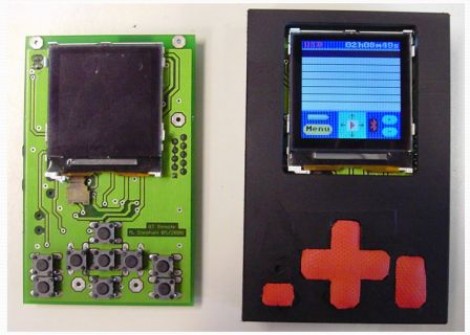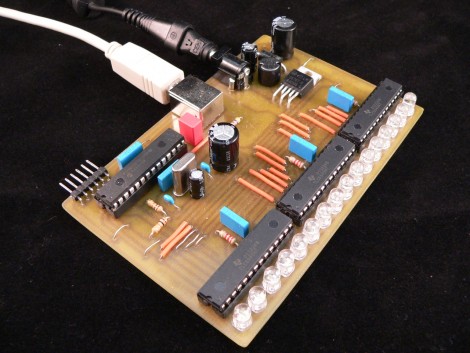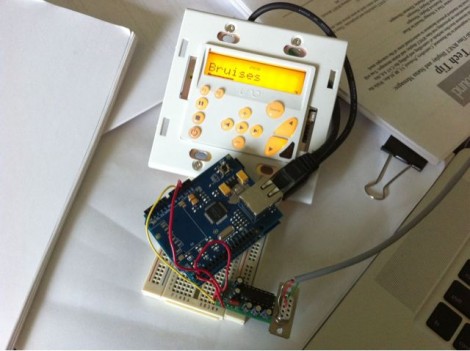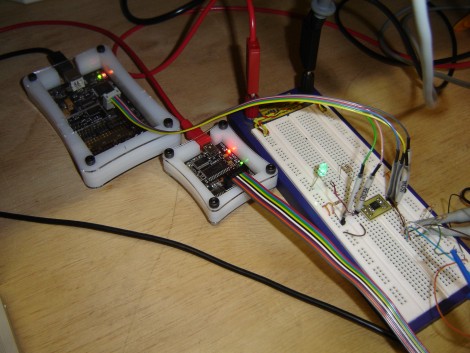[Stewart Allen] acquired a Mindstorm kit about a month ago and he’s already building his own sensors for it. He wanted a more accurate range finder with a narrower measurement field than the stock sensor. Mindstorm has the option to communicate with sensors via an I2C bus. [Stewart] set up an ATtiny45 to act as a the slave on the bus, facilitating the analog measurement of the distance voltage by using and lookup table, and handling the data transfer with the NXT brick. His testing setup is pictured above, with an AVR Dragon for programming the tiny45 and a Bus Pirate for sniffing the I2C data during the development process. The sensor, looking great on a professionally made PCB he ordered, requires a simple driver that [Stewart] hammered out for use with leJOS, the alternative Mindstorm firmware we’ve seen before.
Author: Mike Szczys6403 Articles
Bluetooth Multimedia Remote

[Mathieu] spent three months developing this multimedia remote control. It connects to a PC via USB or Bluetooth and communicates with Winamp to pull down track information for display on a Nokia LCD screen. It can also be used as a wireless headset via the two on-board jacks. [Mettieu] thinks it’s just a small hop away from working as a Skype client if you take the time to write a plugin for that API.
RGB VU Meter

[Simon Inns] turned out this VU meter with a 16 RGB LEDs. He’s using three 16-bit TLC5940NTG LED drivers for the project. They’re not cheap chips but they do a great job. If you were looking to save on parts [Simon] found there’s more than enough brightness and any loss due to multiplexing would not be a problem. The device connects to a computer via USB thanks to the PIC 18F2550 which he’s used in his past VU meter projects. One of the design choices he made was to use a switching power supply. The LM2576 (datasheet) has no problem sourcing 3A at 5V and in addition to two electrolytic capacitors which are commonly used with linear regulators, you just need to add a diode and an inductor.
The meter offers several different configurations which are set on the PC side of things. These include the colors that are used and if the entire bars is used as one meter or split into sections to display both audio channels. Check it out after the break.
TxtBomber
The txtBomber is a high-tech graffiti printer developed by [Felix Vorreiter]. Details are a bit scarce but the video clip after the break proves that this works quite well. [Felix] admits this is Arduino powered but we’re going to have to guess at the rest of the setup from the pictures. He says there are built-in-pens so we’d bet there’s a felt-tip type of thing going on and those look like seven solenoids that actuate them. He posted a picture of the handle side of the device and we can make out two wheels that are connected to LEGO gears. This tracks movement of the txtBomber across a surface in order to synchronize the printing process. There’s no sign of an LCD so it looks like you have to pre-program the messages before you go out into the field.
This is akin to the Chalkbot, but the messages that leaves wash away with the rain. This one seems like it might get you into some trouble if you get caught leaving permanent tags around the neighborhood.
Using Makerbot For Dishwasher Repair

[Daryll Strauss’] dishwasher had some problems that he traced to a worn out part on the upper spinning arm. The hackerspace he belongs to has a Makerbot and he though this would be the perfect opportunity to print his own replacement part. He picked up some inexpensive digital calipers and set to work mapping out the dimensions of the broken piece. He took his hand-drawn cross section and built a replica part in Blender. Once he had it just right he generated the g-code and printed the part. His replacement works very well, and it’s a bit thicker (by design) than the original so hopefully that means it will hold up longer.
Wine Cask Sensor Suite

As part of his Master’s dissertation [Salvador Faria] built a sensor suite for wine monitoring. He needed to develop a method of tracking data inside the wine cask during the vinification process. What he came up with eclipses the wine cellar temperature monitors we’ve seen before.
He picked up pH, temperature, carbon dioxide, alcohol, and relative humidity sensors from familiar vendors like Seeed, Parallax, and SparkFun. His original idea was to develop a floating probe that housed the entire package but he had quite a bit of trouble getting everything inside and maintaining buoyancy. The solution was a two-part probe; the stationary portion seen mounted on top of the cask houses the microcontroller, RF 433 MHz transmitter, and the gas sensors. Tethered to that is a floating probe that measures pH and temperature. Data is sent over radio frequency to an HTTP POST server every minute.
Making Home Automation Modules Talk To Each Other

[Danny] has been working on an RNET to Sonos bridge. These are devices from two different manufacturers used to facility whole-house audio systems. Usually there’s a main controller with a large color screen and then several satellite controllers like the one above which have some of the features but at a lower cost. Normally you’re limited to using hardware from one line of devices in order to get them to talk to each other but [Danny’s] saying ‘no way’ to that restriction.
His latest post has some of the details on how he pulls this off. He used an RS232 serial connection with an Arduino to sniff out the data stream from the RNET base unit. Once he figured out the protocol he used the Arduino to parse all incoming commands, format them for the Sonos controller, and send it over the Ethernet cable to that device. He’s got everything tied together and working. Take a look at the proof in the clip after the break.
Continue reading “Making Home Automation Modules Talk To Each Other”












